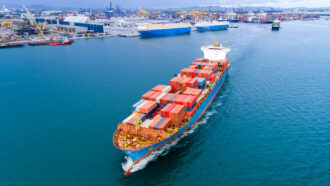Shrinking glaciers
Most glaciers around the world appear to be getting smaller.
By Emily Sohn
I’d rather sit in a hot tub than play in the snow. I like my drinking water without ice cubes. I think winter storms are wonderful, as long as I’m sitting inside next to a warm fire. In other words, I’ve never been a big fan of ice. Until, that is, I went to Alaska.
On a recent sea-kayaking trip off the state’s southern coast, I spent a day paddling around icebergs and staring at a massive glacier that had crept down a valley to leave a wall of ice where it sloped down to the sea.
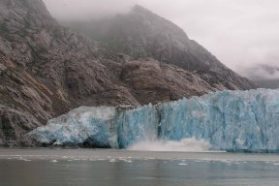 |
|
When a tidewater glacier calves, large chunks break off and crash into the water.
|
| Photo by Julie Ann Miller |
Every once in a while, enormous chunks of ice crumbled off the glacier’s sheer, blue-white face and went crashing into the water. Even when we were miles away, we could hear thunderous roars echoing off the icy mass as it split apart.
It was one of the most spectacular sights I’ve ever seen. I found myself starting to care about ice, especially the ice in Alaska. Thousands of glaciers dominate the landscape there and elsewhere, in polar and mountainous places around the world.
But the world’s glaciers have been shrinking in recent decades. This trend may be a sign of global warming, many experts say. Melting glaciers are already starting to have far-reaching effects on ecosystems around the world (see “A Change in Climate”).
“Years ago, some glaciers were getting bigger, some were getting smaller, and some were staying where they were,” says Keith Echelmeyer. He’s a geophysicist and glaciologist at the University of Alaska, Fairbanks. “Very few are getting bigger now.”
Moving ice
A glacier, by definition, is a moving hunk of snow and ice that stays frozen from year to year.
The type of glacier that I saw on my kayaking trip is called a tidewater glacier. Other types include alpine glaciers, which are in the mountains; ice sheets, which cover large expanses of land; and surging glaciers, which usually move slowly but can sometimes spurt forward 20 or more feet a day.
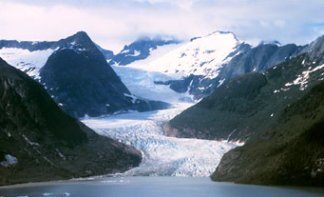 |
|
As it moves, a glacier carves and grinds up rock.
|
| NOAA Photo Library |
Glaciers shape both landscapes and lives. As it moves, the thick ice carves rock, gouging out valleys. Polar bears, whales, seals, and otters all depend on glaciers to stir up nutrients and fish as the ice repeatedly thaws and refreezes.
Seabirds like to nest and rest on glaciers. People who hunt, in turn, count on glaciers for attracting animals. As ice disappears, however, animals lose their habitats and hunters have a harder time finding prey.
Even people who live in hot places have reason to worry, Echelmeyer says. The world’s glaciers hold a lot of freshwater, and their melting makes sea levels rise. Low-lying places such as Florida and Bangladesh are then at greater risk for flooding.
As oceans get warmer and fuller, they also change wind and weather patterns. Droughts, storms, and other extreme climate shifts follow (see “Recipe for a Hurricane” and “A Dire Shortage of Water”).
Changing times
Echelmeyer wants to know how much things are changing. He and his colleagues have been collecting data from about 100 glaciers in Alaska and Washington State since 1993.
He uses a small, 2-person plane equipped with a highly accurate global positioning system (GPS) device, laser beams, video cameras, and other tools. The GPS device tells him, second by second, exactly where he is to within a centimeter or so.
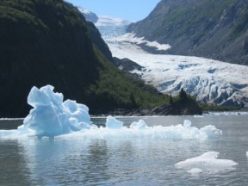 |
|
Alaska’s glaciers appear to be melting at an alarming rate.
|
| Emily Sohn |
To collect data, Echelmeyer flies slowly a few hundred feet above the ice. Then, based on how long it takes for the laser light to reach the glacier and bounce back, he can tell how far away he is from the glacier and how tall it is. Finally, he compares this information with measurements from previous years and maps dating back to the 1950s.
From the mid-1990s to 2001, results show, the tops of Alaska’s glaciers have been shrinking at a rate of about 3 feet a year. Near the edges, they’re going at about 10 feet a year.
“That’s pretty fast,” Echelmeyer says. Glaciers in the warmest places, at low altitudes and southern latitudes, are melting especially quickly.
Using computer models to analyze the data, Echelmeyer found that Alaska’s melting glaciers, sea ice, and a type of frozen soil called permafrost are adding an extra 0.3 millimeter a year to the depth of oceans. Between the 1950s and 1990s, Alaskan glaciers contributed only half that much water.
Fractions of a millimeter might not sound like much, he adds, but all that water adds up.
A coastal village called Shishmaref in northwest Alaska is one of the first signs of what the future might hold. The ocean is taking over the coast, storms keep flooding the village, and permafrost is melting and crumbling away. The U.S. government expects to spend hundreds of millions of dollars moving Shishmaref’s 600 residents away from the threatened village.
Climate change
Overall, sea levels around the world have been rising about 3 millimeters a year since the 1990s, Echelmeyer says.
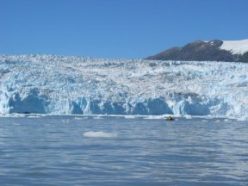 |
|
Glaciers are powerful but fragile.
|
| Emily Sohn |
Underlying the problem of glacial melting, Echelmeyer says, is an even deeper problem: global warming.
Cars and industrial plants spit out carbon dioxide and other so-called greenhouse gases. These gases accumulate in the atmosphere, trapping heat. The temperature rises.
Glaciers just can’t stand the heat. A team of scientists recently reported that, with the way things are going, summers in the Arctic might become completely ice-free within the next century. This area hasn’t lacked ice at any time in more than a million years.
Glaciers are powerful but fragile. Scientists are still learning basic facts about what they’re made of, how they move, and how fast they go.
“I love glaciers,” Echelmeyer says. Now, I know how he feels.
Going Deeper:
News Detective: Alaska’s Weird Weather
Glacier Facts
- Presently, 10 percent of the world’s land area is covered with glaciers.
- Glaciers store about 75 percent of the world’s freshwater.
- Antarctic ice is more than 4,200 meters thick in some places.
- In the United States, glaciers cover more than 75,000 square kilometers, with most of the glaciers located in Alaska.
- During the last Ice Age, glaciers covered 32 percent of the world’s total land area.
- If all land ice melted, sea level would rise approximately 70 meters worldwide.







